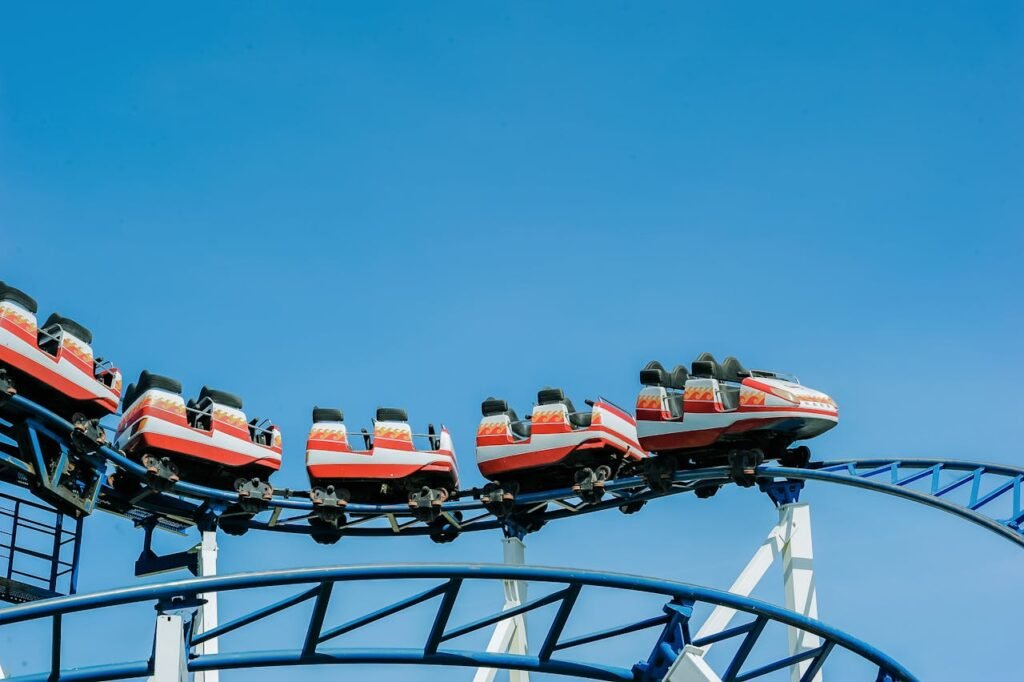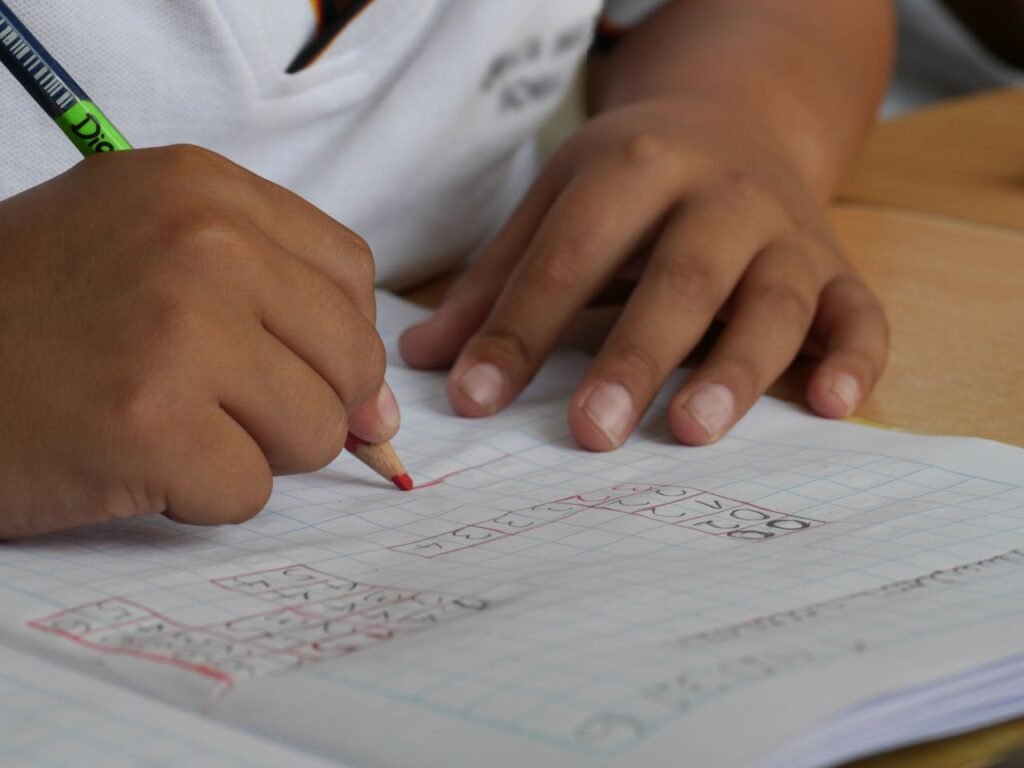Have you ever screamed your lungs out on a roller coaster? Felt your stomach drop as you zoom down a steep hill? Or laughed nervously while hanging upside down?
All those feelings — the thrills, chills, and even butterflies in your belly — come from one thing: physics.
Yes, every twist, turn, loop, and drop on a roller coaster is carefully designed using science. The engineers who build roller coasters don’t just guess what will be fun — they use the same physics you learn in school to make rides fast, safe, and super exciting.
In this article, we’re going to take a ride through the science behind roller coasters. We’ll talk about how energy moves, why gravity is your invisible ride partner, and how force and motion work together to make your heart race (in a good way!).
Don’t worry — we’ll explain everything in super simple words. You don’t need to be a science expert. Just bring your curiosity — and maybe hold on tight.
The Secret Behind Every Ride: Energy
Before a roller coaster moves an inch, there’s something working quietly behind the scenes: energy.
When a roller coaster is sitting still at the bottom of the track, it doesn’t have much energy. But the moment it’s pulled up to the top of that first big hill — now, it’s loaded with potential energy. That’s the kind of energy something has when it’s ready to move but hasn’t started yet.
Think of it like a stretched rubber band, a wound-up spring, or a ball sitting at the top of a slide. It’s full of energy — just waiting to go!
Climbing to the Top
Most roller coasters begin with a slow ride up a tall hill. That climb isn’t powered by magic — it’s often a chain or cable pulling the train up. This part is usually the only time a motor is really doing the work.
Why? Because once the coaster reaches the top, gravity takes over.
Gravity: The Ride’s Real Power
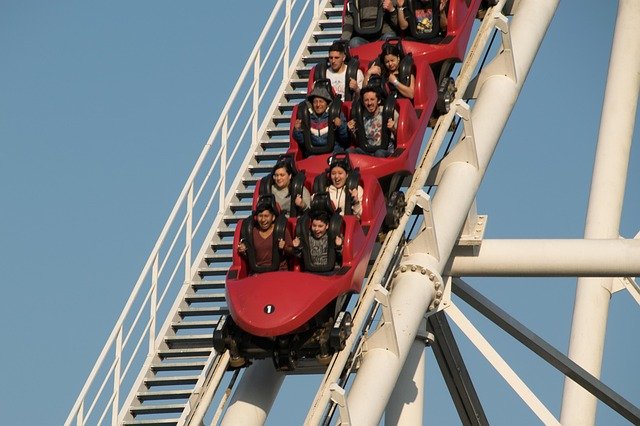
Gravity is the force that pulls everything down toward the Earth. It’s what makes apples fall and people stay on the ground. On a roller coaster, it’s also what makes you scream.
Once the coaster reaches the top of the hill, gravity pulls it down, and that’s when the ride truly begins.
As the coaster drops, all that quiet potential energy changes into something loud and fast — kinetic energy, the energy of motion.
The faster the drop, the more kinetic energy it has.
Up and Down and All Around
After the first big drop, the coaster keeps moving through the rest of the track using the energy it built up.
- When it goes up again, it slows down because it’s using energy to fight gravity.
- When it goes down again, it speeds up because gravity is helping out.
This back-and-forth between going up (slowing down) and going down (speeding up) is what gives the ride its rhythm — that thrilling mix of fast and slow, high and low.
Loops, Turns, and Screams: It’s All About Forces
Now let’s talk about what happens when you hit a sharp turn or go upside down in a loop.
When a roller coaster changes direction — whether it’s turning left, spinning, or looping — it’s not just moving fast. It’s changing how the forces act on your body.
This is where something called centripetal force kicks in. That’s the force that keeps you in your seat when the ride loops. Even when you’re upside down, it pushes you toward the middle of the loop — not out of your seat.
So the next time you’re hanging upside down screaming, don’t worry — physics has your back.
Stopping Without Slamming: How Roller Coasters Slow Down
Roller coasters go fast — but they also need to stop safely. Imagine if a roller coaster ended with a sudden stop… ouch! That’s why smart science and smart brakes work together to slow things down gently.
Magnetic Brakes: Stopping with Science
Many modern roller coasters use something called magnetic brakes. They don’t touch the train at all, but they can still slow it down. Here’s how:
- As the coaster moves, it passes through strong magnets on the track.
- These magnets create a force that pushes against the motion of the train.
- This slows it down smoothly — without any jerky stops or screeching sounds.
And guess what? These brakes work without any power — they use the coaster’s own motion to slow it down!
This kind of safe slowing down is a perfect example of how physics helps roller coasters feel exciting, but not scary.
Safety First — Always
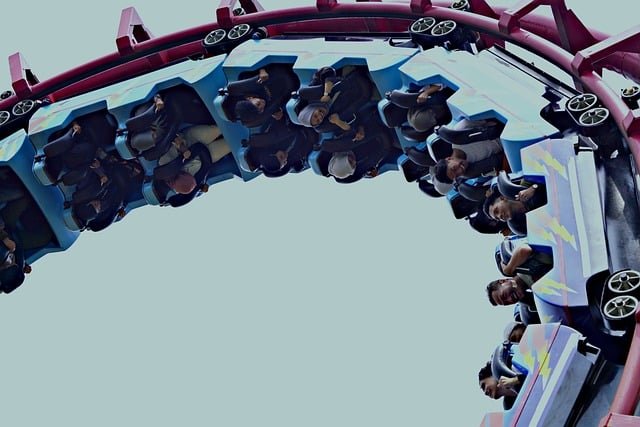
Roller coasters might feel wild, fast, and even a little scary — but they are actually some of the safest rides in the world. Every drop, turn, twist, and loop is carefully planned and tested over and over again.
Why? Because when it comes to building roller coasters, safety is always the most important thing. The thrill should make your heart race — not your parents’.
Let’s look at how science, math, and smart design work together to keep every rider safe.
1. Physics Keeps You in Place
You might think that what keeps you in your seat during a loop is the seatbelt or safety bar. And yes, those help — but the real hero is physics.
When the coaster goes around a loop, centripetal force keeps pushing you toward the center of the curve. Even when you’re upside down, this force holds your body in place. The ride is designed to go at just the right speed — fast enough to keep you safe, but not too fast to feel dangerous.
So while you might feel like you’re flying, physics is actually keeping you snug and safe.
2. Strong, Smart Design
Roller coasters are built using strong materials like steel and wood. But it’s not just the material that makes them safe — it’s the way the tracks are shaped and how each curve is designed.
- Every slope, curve, and twist is tested using computer models before a single piece of track is built.
- Engineers run thousands of simulations to make sure the ride works perfectly under all conditions — hot days, rainy days, heavy loads, and more.
- Even the angle of every seat is designed to help spread out the forces safely across your body.
Nothing is left to chance.
3. Harnesses, Lap Bars, and Belts
Before the ride even starts, you’re locked in tight. But did you know these safety features are designed using science too?
- Lap bars hold you in from the waist and adjust to your size.
- Over-the-shoulder restraints keep you secure during loops and flips.
- Some coasters even use a soft seatbelt that adds extra comfort and safety.
These are tested by both real riders and robots to make sure they hold tight — even in the fastest, twistiest parts of the ride.
4. Constant Checks and Tests
Roller coasters aren’t just tested when they’re built — they’re tested every single day.
Before the park opens:
- Workers walk the track and check for anything unusual.
- The ride runs empty tests to make sure it’s working smoothly.
- Safety systems are inspected and buttons are tested again and again.
If something doesn’t look or feel right, the ride is shut down and checked completely. No risks allowed.
5. Engineers Who Obsess Over Safety
The people who build roller coasters love thrills, but they care even more about safety. Every ride has to pass strict safety rules set by engineers, scientists, and ride inspectors from around the world.
These rules check:
- How much force a rider feels
- How fast the coaster moves
- How secure every part of the ride is
Only after a ride passes all the safety rules is it allowed to open.
The Science of Fear and Fun
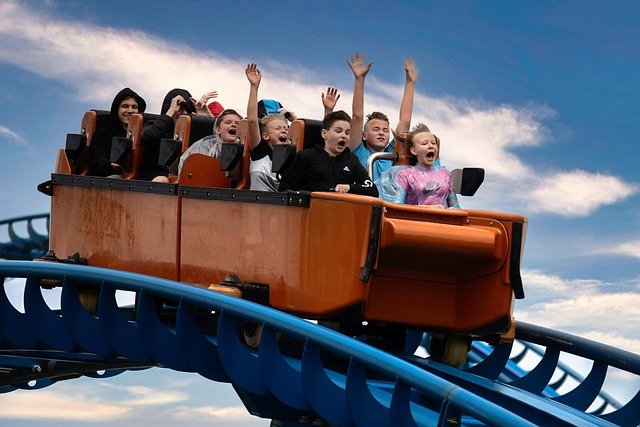
Why do people scream, laugh, and throw their hands up when they’re on a roller coaster? Why do we go back in line again and again, even after we just got off?
It’s not just about going fast. It’s about how the ride feels — and how your body and brain work together to turn fear into fun.
Roller coasters use a mix of forces, movement, and surprise to create excitement. But there’s also a secret science happening inside you — in your muscles, your heart, and even your brain chemistry.
1. Your Body Reacts to the Forces
When a roller coaster drops suddenly or turns sharply, your body feels it. That’s because of something called g-forces — short for gravitational force.
- When the coaster speeds up or goes around a curve, you’re pushed into your seat. You might feel heavier, like something is pressing you down.
- When it drops, you might feel lighter — even like you’re floating out of your seat. This is called airtime, and it’s one of the best parts of the ride!
These changes trick your body — it feels like it’s flying, falling, or floating, even though you’re strapped in and totally safe.
2. Your Brain Loves a Good Scare
Believe it or not, your brain actually enjoys being scared — if it knows you’re safe.
Here’s what happens:
- The ride drops suddenly, your body feels a jolt, and your brain says, “Whoa! What’s going on?”
- For a moment, your “fight-or-flight” system kicks in. Your heart beats faster, your breath quickens, and your senses sharpen.
- Your brain releases dopamine and adrenaline — chemicals that make you feel alert, happy, and even a little bit wild.
That mix of fear + safety creates a powerful feeling: excitement.
It’s the same reason people love watching scary movies or playing spooky games — your brain gets the thrill without the danger.
3. Surprise Makes It More Fun
Roller coaster designers are smart — they know that surprise makes a ride better.
- Just when you think the drop is over — boom! Another turn.
- You’re laughing from a twist — then suddenly you’re upside down.
- A quiet climb becomes a wild spin with no warning.
Your brain can’t guess what’s coming next, and that makes every second more exciting.
This surprise, mixed with physical forces, keeps your mind focused, thrilled, and fully in the moment — and that’s why people say roller coasters make them feel “alive.”
4. It’s Fun Because You’re in Control — Kind Of
Even though you can’t drive the roller coaster, you made a choice to ride it. That sense of controlled danger is part of what makes it fun.
- You’re safe, but it feels like you’re flying.
- You’re strapped in, but it feels like you’re weightless.
- You’re on a track, but it feels like chaos.
And that makes the whole ride a perfect mix of science, emotion, and imagination.r body reacts like something amazing is happening. That’s what makes it fun!
How Roller Coasters Are Designed Using Math and Physics
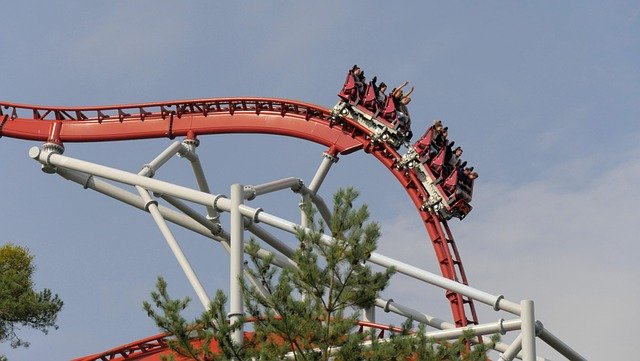
Behind every scream and thrill on a roller coaster is hours — even years — of planning, testing, and number-crunching.
Engineers don’t just build big hills and hope for the best. They use math and physics to make sure everything works perfectly.
Here’s how it all starts:
1. Measuring Energy and Speed
Before they build anything, roller coaster designers calculate how much energy the coaster will need to make it through the whole track.
- They figure out how high the first hill needs to be.
- They measure how fast the train will go after each drop.
- They calculate how much energy is lost to friction (rubbing) or air resistance.
This helps them shape the track so the coaster never gets stuck and never goes too fast.
2. Drawing the Track
Designers then use computers to draw the curves, hills, loops, and turns. Every line on the screen is backed by equations — how steep is too steep? How sharp is too sharp?
Even the smallest mistake in these numbers can change the entire ride. That’s why math and physics are the backbone of the whole design.
Wood vs. Steel: The Science of Coaster Types
Not all roller coasters are the same. Some are loud and bumpy. Others are smooth and quiet. That’s because they’re made from different materials — and each one changes how the ride feels.
Wooden Coasters
These are the classic roller coasters. They creak and shake, and you feel every twist and turn.
- Built for big drops and small hills
- More bounce and “rattle”
- Slower but feels more “wild”
Wooden coasters don’t usually have loops, because the structure can’t bend as much as steel.
Steel Coasters
These are the smooth, twisty ones you often see at big theme parks.
- Stronger and more flexible
- Can go faster and do loops, spins, and corkscrews
- Feel smoother and more modern
The type of material changes what kinds of forces you’ll feel — and how the coaster can be shaped.
How Kids Can Learn the Science of Roller Coasters
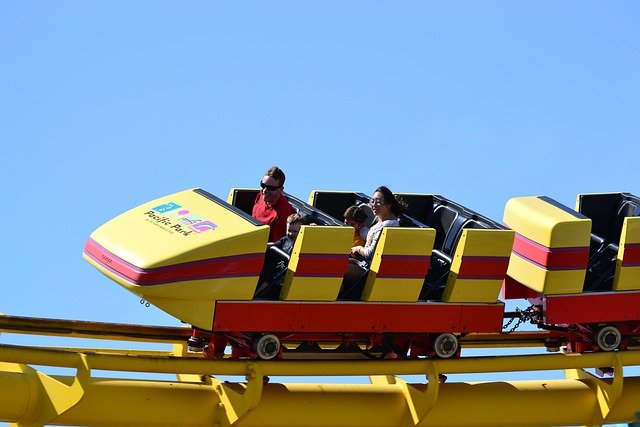
Kids love roller coasters because they’re wild, exciting, and full of surprises. But what if we told you that all that fun is powered by science — and that your child can learn to understand and even build that science too?
The best part? It’s not as hard as it sounds. In fact, with the right guidance, kids can start learning the same concepts roller coaster engineers use — using real-life experiments, hands-on activities, and playful problem-solving.
Here’s how Debsie makes it all come to life.
1. Turning Curiosity into Real Science
Most kids already ask great questions:
- “How does the roller coaster stay on the track?”
- “Why don’t people fall out when it goes upside down?”
- “Why is the first hill always the tallest?”
At Debsie, we listen to those questions — and turn them into lessons that make science feel exciting and real.
Instead of memorizing formulas, kids explore ideas like gravity, force, and energy in ways they can see, feel, and try for themselves.
We don’t rush. We build slowly — one fun concept at a time.
2. Real Experiments, Real Learning
Our students don’t just watch videos or read notes — they do science.
Want to learn how loops work? They build one out of paper and marbles.
Want to understand gravity and friction? They test ramps and track angles using toy cars.
Every activity is:
- Safe to do at home
- Easy to understand
- Designed by expert educators
- Built around play and discovery
Because when kids build their own roller coaster models, they’re not just having fun — they’re learning physics without even realizing it.
3. Built for All Ages and Skill Levels
Whether your child is just starting science or already loves STEM, we meet them where they are.
- Young learners (ages 5–9) get simple, playful projects to explore cause and effect, motion, and building.
- Middle schoolers (ages 10–13) dive deeper into energy, force, and speed with real-world examples.
- Teens (ages 14–18) learn more advanced concepts like centripetal force, momentum, and mathematical modeling — the same tools used in engineering!
With each step, we help them grow smarter, more confident, and more curious.
4. Learning That Sticks for Life
When kids connect what they’re learning in class to something they already love — like theme parks, racing games, or rides — it stays with them.
That’s our magic formula at Debsie:
- Take what kids already enjoy.
- Add a spark of wonder.
- Teach them how it works in the real world.
This doesn’t just help them in science class. It helps them build:
- Focus
- Creativity
- Smart problem-solving
- Resilience and critical thinking
That’s the kind of learning that lasts a lifetime.
How Debsie Turns Everyday Wonders into Real Science

At Debsie, we believe science isn’t just something you read in textbooks — it’s happening all around you, every day.
That thrill on a roller coaster? That’s physics.
The way a soccer ball curves mid-air? That’s motion and force.
Even how your cereal spins in milk? That’s surface tension and density!
Children are naturally curious. They notice things. They ask questions. At Debsie, we take those questions and turn them into powerful learning moments.
1. We Use Real-Life Examples Kids Already Love
Most kids light up when they talk about roller coasters, skateboards, airplanes, or space. Instead of starting with formulas and dry theory, our teachers start with what kids already enjoy — and build learning from there.
- Want to understand loops? We use toy cars and paper tracks.
- Curious about gravity? We show how it powers your favorite rides.
- Not sure what friction is? Let’s test it using slides, ramps, and marbles.
This way, kids connect the dots between their real world and the science behind it.
2. Our Lessons Are Hands-On, Minds-On
Kids don’t just watch or listen — they do. Every Debsie lesson is designed to be:
- Interactive
- Experiment-based
- Built around active thinking and doing
Whether they’re building a model roller coaster at home or testing angles and forces with everyday objects, students experience the joy of figuring things out for themselves — guided by expert teachers who explain each step in the simplest, clearest way.
This approach turns “I don’t get it” into “Whoa — now I see how it works!”
3. We Explain Hard Ideas in Simple Ways
Roller coasters involve gravity, acceleration, centripetal force, and energy transfer — big science words that can be confusing at first.
But at Debsie, we explain everything in third-grade-level English — with friendly examples, stories, and visuals that make sense instantly.
We break big ideas into small, easy pieces. So no matter your child’s age or level, they’ll understand deeply and remember what they learn.
4. We Turn Learning into a Game
Just like roller coasters are fun, learning at Debsie feels exciting too. We use:
- Gamified lessons
- Points, badges, and rewards
- Creative challenges and puzzles
This makes kids want to keep learning — not because they have to, but because it’s fun, rewarding, and makes them feel smart.
And when kids enjoy the process, they learn better and faster.
5. We Build Thinkers, Not Just Students
More than just facts, Debsie teaches kids to:
- Ask questions
- Test ideas
- Make connections
- Solve problems creatively
We’re raising a generation of smart thinkers — the kind who look at a roller coaster and say, “I know how that works — and maybe one day, I’ll design one too.”
Conclusion: Learning That Feels Like a Ride
Roller coasters aren’t just wild rides — they’re full of science. Every drop, loop, twist, and turn is powered by energy, motion, force, and smart design. What feels like chaos is actually a carefully planned mix of physics and fun.
And now you know how it all works.
But more importantly, your child can learn it too — not just to pass a test, but to understand the world deeply, with confidence, curiosity, and joy.
That’s what we do at Debsie.
We take the everyday wonders that make kids ask “Why?” and turn them into moments of real learning. Whether it’s a roller coaster, a rainbow, or a falling apple, our teachers help kids explore science in a way that’s clear, hands-on, and unforgettable.
🎢 Want your child to fall in love with learning?
👉 Try a free Debsie class today — and let them discover how science is not just something they learn… it’s something they live.
Read next:
